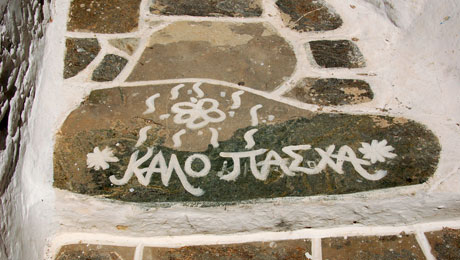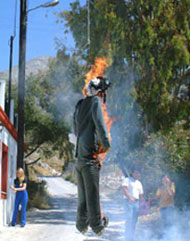Picture: www.clickatlife.gr
Easter is the most important Christian holiday in Greece and it is celebrated traditionally, especially in rural areas, where a lot of traditions come alive. Besides the religious significance of the holiday, the fact that it coincides with the spring is a good opportunity to escape city life and visit the beautiful islands. The exciting atmosphere of the narrow streets among picturesque houses with flowering gardens and freshly painted churches are images that can hardly be described in words.
Easter and the Dodecanese Islands between Crete, Samos and the coast of Asia Minor give their best. Coated in the green colour of the spring, white touches of flower gardens and blue hints of sea and sky, the Aegean Islands fascinate both residents and visitors and, in bright days, meadows are dotted with wild flowers, the scent of thyme and the mastic tree can be smelt everywhere and churches prepare to receive believers.
Easter customs of the Dodecanese

Rhodes, the largest of the Dodecanese islands and the fourth in size in Greece, is known for its custom of the pool in Agios Isidoros, which starts from Holy Saturday and ends on Bright Monday. All the single men of the village take part in it, following certain rules, and those who disobey these rules are thrown into the pool of water.
Also, on Good Friday’s Eve people light a bonfire, symbolising the burning of Judas, which remains lit until Easter Sunday.
The Easter table includes the traditional soup "magiritsa" and boiled goat's head, and on Sunday – the local Easter dish "lambriati" (a lamb or goat, stuffed with rice). Women make pretzels called “lazarakiya” on Lazarus Saturday.

On the island of Karpathos, Easter traditions are notable in the mountain village of Olympos, where residents follow the tradition of sorrow and mourning during Bright Week, but also at Easter itself, which reaches its peak on Bright Tuesday. After the service on Good Friday, on Great Saturday women prepare lamb or goat stuffed mainly with rice for the next day. On the Monday after Easter women go to bakeries in order to roast Easter flat cakes with cottage cheese and spices; then they go to the cemetery in order to clean and decorate graves with flowers. On Bright Tuesday, residents of the village decorate icons in the church with colourful towels and carry them going back to the cemetery.
On the Aegean island of Astypalaia, women make yellow bagels - bagels with no sugar, but spicy and flavoured with saffron, a precious spice derived from the flower of Crocus sativus, which is harvested each autumn in the mountains. On Easter Sunday, after the morning liturgy, Judas is burned under the impressive citadel, and then a feast with a special taste of an island holiday follows.

The island of spongers, Kalymnos, boasts traditional Easter customs. On Easter Sunday, groups of local youths climb the two hills that rise above the harbour, carrying dynamite. Just after 5 p.m., a signal is given and explosions begin. They continue until late at night. The traditional Easter dish is called "Mououri " - stuffed lamb the preparation of which requires hours. It remains in the stove all night until Sunday morning. Making the fire in the stove in the afternoon on Holy Saturday is a ritual.
On the small island of Kastelorizo, almost on the Asia Minor coast, one of the most beautiful traditions is the dance of girls in the yard of the Metropolitan Church. Traditional sweets and an almond soft drink are also made.

Patmos, the island of the Apocalypse, with its fortress and monastery, which dominates the whole Aegean Sea, celebrates Easter in its own way. Starting from Palm Sunday, decorations, festive tables and religious traditions immerse the visitor in the Easter atmosphere. The liturgy in the chapel of St. John is worth seeing. The chapel was built in the cave in which John the Baptist lived in seclusion. The custom that makes the feast of Patmos special is the ceremony of washing in the morning on Good Friday, which includes a recreation of the Last Supper: the abbot, just like Jesus, washes the feet of 12 monks who sit around a big table, like the apostles at the Last Supper. On Good Friday, a recreation of the Deposition of Christ is made at Saint Joan Monastery and, in the evening, everybody meets in the squares of the villages of Skala and Hora. On Easter Sunday, the Gospel is read in seven languages in the monastery.